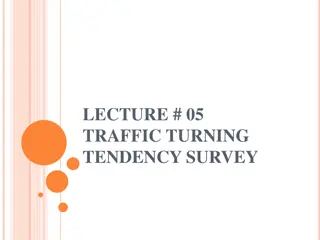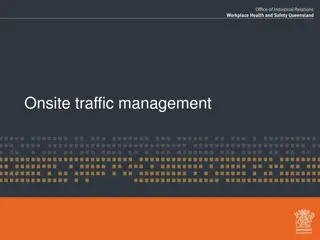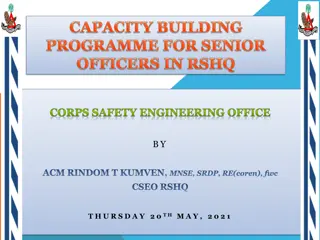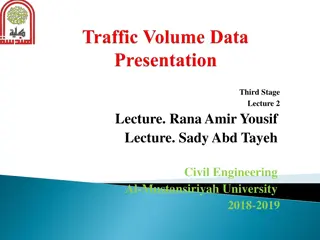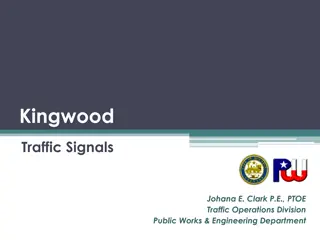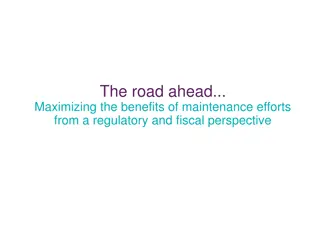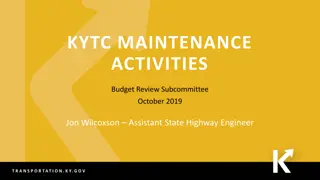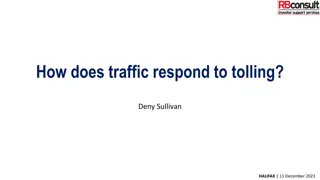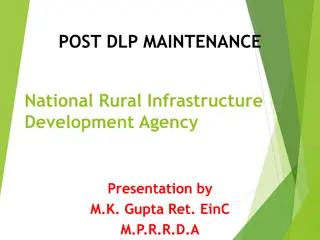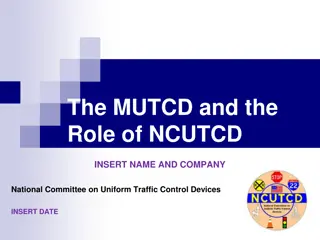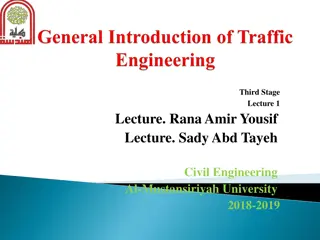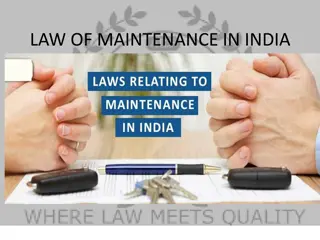Importance of Vehicle Maintenance for Traffic Officers
Regular vehicle maintenance is crucial for extending vehicle life and reducing running costs. This lecture focuses on automobile maintenance and aims to cultivate a culture of timely maintenance among participants. It covers types of vehicle maintenance, steps in maintenance procedures, and practical ways to ensure maintenance is carried out effectively, with a particular emphasis on planned maintenance. Daily/routine maintenance, preventive maintenance, and overhaul are explained, along with a suggested acronym for easy reference during checks. Safety measures like checking lighting systems are also discussed.
Download Presentation

Please find below an Image/Link to download the presentation.
The content on the website is provided AS IS for your information and personal use only. It may not be sold, licensed, or shared on other websites without obtaining consent from the author.If you encounter any issues during the download, it is possible that the publisher has removed the file from their server.
You are allowed to download the files provided on this website for personal or commercial use, subject to the condition that they are used lawfully. All files are the property of their respective owners.
The content on the website is provided AS IS for your information and personal use only. It may not be sold, licensed, or shared on other websites without obtaining consent from the author.
E N D
Presentation Transcript
VEHICLE MAINTENANCE VEHICLE MAINTENANCE AND AND FIRE PROTECTION AND PREVENTION FIRE PROTECTION AND PREVENTION 1
VEHICLE MAINTENANCE INTRODUCTION Regular vehicle maintenance extends the life of a vehicle and cuts down on running cost. It is usually advisable not to cut corners on maintenance of vehicles, as this could be dangerous. For the purpose of this lecture, the maintenance shall focus on automobile (car) maintenance. 2
AIM The lecture aims at making participants to imbibe the culture of regular and timely maintenance of vehicles; and as Traffic Officers in the Corps, to ensure that enforcement is pursued to this regard. OBJECTIVES At the end of this lecture, participants should be able to: 1. Enumerate types of Vehicle Maintenance; 2. List steps in carrying out the various Vehicle Maintenance; 3. Highlight practical ways in ensuring Vehicle Maintenance. 3
CLASSIFICATION OF VEHICLE MAINTENANCE Maintenance can be classified as Planned Maintenance and Unplanned Maintenance. Planned Maintenance: It is the maintenance organized and carried out forethought, control and records. It is preventive in nature as it is done in anticipation of failure. Unplanned Maintenance: This is the work organized and carried out without forethought, control and records. It is curative in nature as it is done after the failure of a component or the whole system. However for the purpose of this lecture, the Planned Maintenance shall be in focus. 4
Types of planned maintenance There are three (3) principal types: Daily/Routine Maintenance; Preventive or periodic maintenance (servicing or trouble shooting); and Overhaul. DAILY/ROUTINE MAINTENANCE This type of maintenance is undertaken in order to forestall anticipated undesirable consequences of breakdown of vehicles. It involves the checking of some components as well as taking action daily, preferably in the morning before starting the engine. 5
For easy reference and collection, the following acronym is suggested: WOFT (FIRST PARADE FOR CAR PETROL ENGINES) W - Water: Check water level in the radiator; O Oil: Check the level of engine oil in the sump using dip stick; F Fan Belt: Check belts for tension and cuts; T Tyres Figure 1: Showing Tyre 6
Check for cuts, punctures, depth of threading, pressure, alignment and wheel nuts. SECOND PARADE (SAFETY PARADE) could include the following: Lighting System: Check the headlamp, side lamp, signal indicators and reverse lights. Brakes and Clutches: Figure 2: Showing the Brake System 7
Check the hydraulic level Check the effectiveness of the brake, start the vehicle, drive off a little and step on the brake pedal to test the effectiveness. Check the tightness and the effectiveness of the brakes and clutches Change all the gears, one at a time while pressing the clutch pedal 1. WIPERS Ensure that the windscreen wiper are functional Check the blades for effectiveness 8
2. STEERING MECHANISM: Check for clearance or freeplay Check for automatic transmission fluid (ATF) for power steering only 3. HORNS Ensure the horns are in good working condition Do not fit wrong horn to your vehicle 4. SPARE TYRE Check spare tyre for cut, puncture, thread and pressure Ensure that jack, jack handle and wheel spanners are in the vehicle. 5. REFLECTIVE TRIANGLE Ensure a pair of reflective triangle is in the vehicle 9
6. FIRE EXTINGUISHER: Ensure the correct type and size of fire extinguisher is in the Vehicle. A multipurpose fire extinguisher is preferable. 7. BATTERY Check the electrolyte (battery liquid) and the condition of battery terminals. Figure 3: Showing the battery in a car 10
2. BODY INSPECTION Take a walk round the vehicle to check for dents and loose parts. Routine Maintenance could be daily or weekly or monthly; depending on the use of the vehicle. PERIODIC (PREVENTIVE) MAINTENANCE OR SERVICE This type of maintenance is carried out on kilometer or monthly basis, depending on the use of the vehicle, as stipulated by the manufacturer s specification. If on Kilometer basis, it could be between 1,500 and 2,000 kilometers. The maintenance involves servicing the vehicle completely by following the following process: 1. Drain the engine oil and refill with new oil 2. Change the engine oil filter 3. Change the contact set (if applicable) 4. Replace the fuel filter with new one. 5. Clean the air filter. 11
6. Check the brake fluid in the master cylinder and top up. 7. Check the fan belt tension with your thump and if cracked replace with new one. 8. Check the electrolyte. One may re-charge or replace as necessary. 9. Check all parts of the electrical system - e.g. horn, lamp, indicators etc. 10. Check the high and low tension cable of the spark plugs and replace if any one cracked. 11. Check the braking system e.g. brake lining and brake pads. If worn-out replace with new ones. 12. Check wheel alignment and correct if necessary. 13. Carry out wheel balancing, if necessary. 14. Tight all loose bolts and nuts. 15. Check gear oil of gearbox and back axle. Top up if necessary. 16. Grease all the areas that need greasing. 17. Clean up the engine and wash the vehicle completely. 12
OVERHAULING: Overhauling operation is so detailed that the job requires skilled personnel to handle it. It involves dropping the engine and dismantling it into component parts. The replacement or reassembly requires specialized handling. One does not have to wait until there is an engine seizure, a knock or any major damage before embarking on an overhaul, as the aim should be preventive. Major overhauling of a vehicle could be done when it has covered a distance of between 50,000 and 60,000 kilometers as may be specified by the manufacturer. The problem that could necessitate overhauling includes: 1. Knocked engine. 2. Engine consuming oil due to worn-out piston rings. 3. Sparking plugs soaking oil. 4. Noisy crankshaft bearing/metal bearings 5. Metallic sound from the engine etc 13
OVERHAULING INVOLVES THE FOLLOWING 1. Removal of the cylinder head, decarbonisation and grinding of the valves. 2. Losing the sump, dismantling the connecting rods, removing of the crankshaft, camshaft. Pistons cappets, oil pump etc. 3. Dismantling the clutch pressure plate, disc plate, release bearing, flywheel and proper examination of components to determine the suitability of continuous use. 4. Examining the piston and rings, crankshaft, camshaft, connecting rods etc. and replacing all defective parts. 5. Inspecting the oil pump, distributor, alternator, Kick-starter and servicing them. 6. Re-coupling the engine after examination and replacement of defective parts. 7. Carrying out all routine servicing as mentioned under periodic maintenance. Overhauling actually gives the vehicle a new life . 14
CONCLUSION It is important that planned vehicle maintenance is carried out on vehicles to ensure effective and efficient workability. Vehicles should not be used to break-down point before maintenance is done. One should avoid a fire-brigade approach with regard to maintenance of vehicles. An appropriate maintenance programme is imperative for any vehicle user. 15
FIRE PROTECTION AND PREVENTION INTRODUCTION Fire is a rapid, persistent chemical change that releases heat and light and is accompanied by flame, especially the exothermic oxidation of a combustible substance. It is important to note that fire is a highly destructive agent. Based on the context of this discussion. Consequently, the killer agent of fire is SMOKE INHALATION which kills more than burns because it is toxic and contains carbon monoxide, hydrogen chloride and carbon dioxide. Fire produces intense heat above 10000f which eventually uses up the oxygen needed for breathing. But in the bid to fight fire which on this course has been termed fire prevention . FUEL, HEAT and OXYGEN are the three major substances needed to ignite fire. Hence, the best way to prevent fire is to isolate sources of fuel and heat in order to prevent combustion. . 16
INTRODUCTION CONTD. The need for proactiveness in fire related issues cannot be overemphasized. This is to say that a fire protection systems or mechanisms has to be in place in the event of an outbreak of fire so as to remedy and save lives and properties. Fire protection comes in different forms viz; (a) Water (ie water mist): The small water droplets allows the water mist to control, suppress or extinguish fire by cooling flame and surrounding gases by evaporation and by the same evaporation oxygen is displayed. (b) Fire Extinguisher: this is applicable in the case of automobile fire, household fire etc. other type of fire protection equipments includes smoke detectors and fire fighting systems specifically designed for trains to mention but a few. 17
AIM: The aim of this lecture is to bring to the knowledge of the participants the dangers in fire outbreak and how to control and prevent it. OBJECTIVES: At the end of this lecture, participants should be able to; Discuss fire accident rescue List the causes of fire Know the procedure for fire protection Know the indications of fire State the size of extinguishers. 18
FIRE ACCIDENT RESCUE Fire is a very destructive agent at home, vehicles etc. An available statistics from the Federal Fire Service shows that property worth over N10 billion is lost to fire annually. 15% of it is to vehicle accident. Incidence of fire on vehicle can only occur when heat, Air or fuel are present. Fire is caused by a rapid combination of two or more substances resulting in the production of heat and light. Combustibles such as petrol, diesel, rubber, wood, paints etc enhance this. About 98% of fire accidents are home induced. Only 2% may be due to motor accidents. Fire is caused by the combination of oxygen, fuel (gaseous, liquid or solid state) and heat. The first two are readily available. But heat is often introduced due to willful act (arson, while cooking, faulty electrical parts, sustained radiation from burning sources from the engine of vehicles, battery terminals while the vehicle roof and tank acts as fuel. 19
Others include careless Cigarette smoking, leaking fuel tank or hoses, thunder, earth quake, willful act of arson, burns, politically motivated fire to cover fraud etc), by accident (power surge, electrical spares, unfortunate incidence motor vehicle collision, spontaneous spark from loose throttle / handbrake cable etc) and by carelessness /negligence, Procrastination, forgetfulness, laziness overloading of electrical sockets, etc). Fire could be spread by convection, radiation and conduction, hence, it is prevented by cutting off its source. fuel 20
The ravaging effect of fire can be stopped by using fire extinguishers. There are different types of fire extinguishers for different classes of fire INDICATION OF FIRE- smell, noise, smoke, increased temperature etc SIZE OF EXTINGUISHER - Car (1kg), Bus (2kg), Truck (6kg), Trailer/Tanker (two of 9kg), houses (water extinguisher at entrance and Co2 in the kitchen, the size depend on the house) FIRE ESCAPE - Location of safety appliance, note the exit in the building, and safety point to assemble after escape 21
CLASSES OF FIRE A -Free combustible material eg Man, cloth. It is extinguished by cooling with Halon based extinguisher but it is environmentally unfriendly B -Flammable liquid or oil- The fire spread more when cooled. It can only be extinguished with chemical foam. The foam is good for petrol induced fire as it blanket O2 and prevent reingnition C -caused by gases- It is difficult to detect its source. It can be fought with Co2 gas. The Co2 shut down O2 supply and it is used in confined fire. D -Metal (in furnace) is not a common class of fire. It is difficult to burn a metal but when it burns high heat is generated. Dry chemical powder is used. It has quick knockdown capacity but do not prevent reignition which is common with vehicle fire. NOTE: Electric fire is caused by any of above classes. Class D fire is stronger than C, C is stronger than B, and B than A. Hence the extinguisher of D can be used for all .But A cannot be used for B and so on. The ABC fire extinguisher is of the class D. In a building the higher floor is at higher risk because victim escape is difficult and the roof is a fuel for fire. In case there is no extinguisher in your vicinity sand and water are natural extinguisher. 22
EXTINGUISHING FIRE PROCEDURE: Disconnect the battery and focus the nozzle of the extinguisher at the base of the fire For engine fire, back the wind, open the bonnet slightly be careful with your eye and attack the fire. For accident involving fuel tankers, invite fire brigade, evacuate residence, divert traffic from a reasonable distance, attack the fire such that the water or foam or Halon being used do not transmit the fire to the fighting engine. Remember that the fuel tanker is under pressure and can explode, give breathing equipment to victims and assist those that cannot breath to roll on the ground or on 6X6 asbestos blankets, do not tow the fuel tanker, flush any fuel soaked areas with detergent mixed with water, that will form blanket on the fire and prevent vehicle skidding. 23
EXTINGUISHING FIRE For vehicle crashing into a river, a breathing apparatus with facemask supply oxygen. The dead is allowed to float after 24 hours, determine the depth of the river and ensure that it is reptile (snake/ Crocodile) free. Check areas covered by weeds to ensure that you do not stumble into quick sand, lay victims on a stretcher, clean his air ways to enable better breathing unless when you are sure the victim is dead, victims are pulled out of the river by divers. For vehicle in a ditch/rocky terrain, use a long thin rope with a hook, rackle a life aid to overcome hindrance of height, but if it is in a ditch tie the rope to a heavy rock or towing vehicle. For vehicle carrying corrosive chemicals, inflammables and dangerous fumes, wear boots, gloves, never fall down, use nose guards, flood the area with water or alkaline, the vehicle would carry information on its goods transported. 24
CONCLUSION Fire has been adduced to be a very destructive agent both at home, with vehicles etc of which statistics show that over 10 billion worth of property is lost to fire. In this regard, people should avoid things such as careless cigarette smoking, leaking fuel tanks, gaseous emissions etc as they can cause fire outbreak. The effective way of fighting fire to a standstill is cutting of its sources by the use of fire extinguisher. It is also important to note that an effective prevention and control of fire entails applying the right formula depending on the class of the fire. 25


